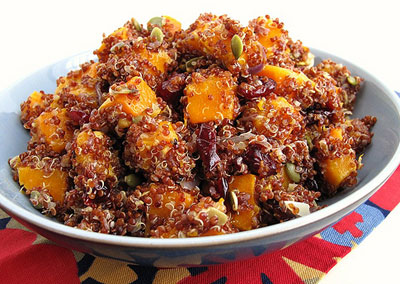 I first heard of quinoa many years ago from a friend who was diagnosed with wheat sensitivity. Quinoa, which is the seed of a flowering plant, is related to spinach and beets. It is not a grain, but is treated like one in recipes. It is suitable for those who suffer from celiac disease and maintain a gluten-free diet. The pseudocereal, as it is officially termed, originates from the Andean region of South America. It was considered sacred in Incan society, second in importance to the potato, and followed by corn. The Spanish conquistadors disliked quinoa, suppressed its production, and it never gained popularity outside of South America.
I first heard of quinoa many years ago from a friend who was diagnosed with wheat sensitivity. Quinoa, which is the seed of a flowering plant, is related to spinach and beets. It is not a grain, but is treated like one in recipes. It is suitable for those who suffer from celiac disease and maintain a gluten-free diet. The pseudocereal, as it is officially termed, originates from the Andean region of South America. It was considered sacred in Incan society, second in importance to the potato, and followed by corn. The Spanish conquistadors disliked quinoa, suppressed its production, and it never gained popularity outside of South America.
What makes quinoa so special is that it is a complete protein with a full set of amino acids, the building blocks of proteins. This especially made it nutritionally significant to pre-Colombian peoples. It continues to be important to vegetarians and vegans. Quinoa can be used in many ways and is available in different forms, including flour, flakes, and the whole seed. The flakes can be eaten like oatmeal or, when combined with flour, baked into cookies, quick breads, pancakes, and waffles. Whole quinoa comes in a few colors, but only two are available in the States, white and red, of which the red has more fiber. Whole quinoa can be cooked and eaten like rice and made into pilafs or stir-frys.
To prepare quinoa, wash the seeds in a sieve under running water or in a bowl in a few changes of water. The reason why is to remove a naturally occurring compound that causes the seeds to taste bitter but serves as a natural deterrent from birds who would otherwise destroy crops. Most commercially sold quinoa is prewashed of this film. Quinoa cooks very quickly: Simmer it in double the amount water or stock for about 15 minutes. You know it's cooked when the curlicue emerges from the seed. It has a nutty flavor and slightly chewy texture, not unlike rice. In this recipe, I combine red quinoa with roasted butternut squash and onions. Garlic and ginger add depth of flavor, the pumpkin seeds, crunch, and the dried cranberries, a touch of sweetness. Try this nutritionally rich food whether on a diet or just to try something new. Even the health food cynic will appreciate the uniqueness of quinoa.
Red Quinoa with Roasted Butternut Squash, Dried Cranberries, and Pumpkin Seeds
1 medium butternut squash, peeled, seeds removed, and cubed
1 large red onion, sliced lengthwise into half moons
5 garlic cloves, skins on
1-inch piece ginger, peeled and finely chopped
3 tablespoons olive oil
coarse sea salt
freshly ground black pepper
1 cup red quinoa, rinsed in water
1/4 cup dried cranberries
1/4 cup hulled pumpkin seeds
Preheat oven to 375 degrees F. Combine butternut squash, onion, garlic, and ginger on a rimmed baking sheet. Drizzle with oil and season with salt and pepper. Toss to coat. Roast until squash is tender, about 20 minutes.
Press garlic from skins. Mash with a knife or fork until a paste forms.
Meanwhile, combine quinoa with 2 cups water in a saucepan. Add a pinch of salt. Bring to a boil, cover, and simmer until tender and most of water is absorbed, about 15 minutes.
Transfer quinoa to a large mixing bowl. Season with salt and pepper. Stir in dried cranberries, pumpkin seeds, and mashed garlic. Carefully fold in roasted vegetables. Serve warm. Yield: 4 to 6 servings as a main dish or 6 to 8 servings as a side dish.
Joseph Erdos is a New York–based writer and editor, butabove all a gastronomer and oenophile. He shares his passion for foodon his blog, Gastronomer's Guide , which features unique recipes and restaurant reviews among many other musings on the all-encompassing topic of food.

